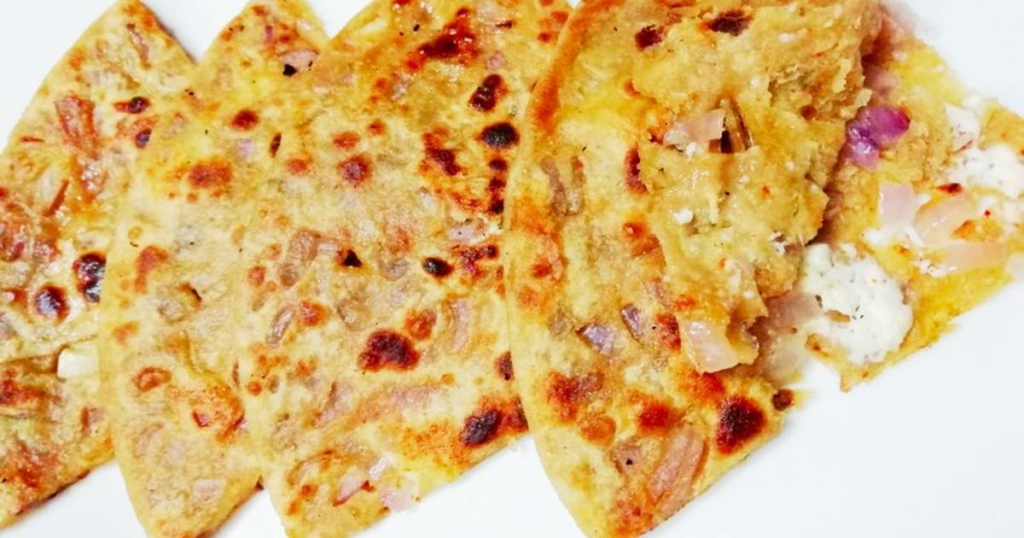Onion Paratha has been a traditional breakfast in India. It is a flatbread made from wheat flour stuffed with onions, spices, and other ingredients. It can be eaten with curry or even as a snack.

Onion Paratha is one of the most popular parathas. You can always stuff it with onions, which are sauteed in butter or oil and then added to the dough. The stuffing is then rolling out and cook on a hot Tawa. The paratha tends to be very soft, so it is fresh and hot.
Onion paratha is a roasted flatbread.
Onion paratha is a kind of flatbread, and it’s also aka pyaz roti. It’s making with unleaven dough rolling out into thin circles. The dough is stuff with a mixture of onions and spices (other ingredients include red or green chilies, cumin seeds, black peppercorns, ginger paste, and garlic paste), which gives it its distinct flavor. Onion parathas are traditionally eaten for breakfast or as an afternoon snack in India.
This paratha is cook by stuffing onions, spices, and herbs into the dough.

Onion paratha is an Indian stuff flatbread cook with unleaven dough. It’s usually prepared with onions, spices, herbs, and vegetables.
The dough you can make from wheat flour, rice flour, or a combination of both.
The paratha you can eat as a breakfast, snack, or appetizer. It is usually serve with a side of yogurt or aalo sabji. Onion paratha is very popular in the northern part of India.
Further reading: 6 Different Types of Veg Parathas You Must Try
Onion paratha tastes very good with chutney and curd (yogurt).
In India, pyaz paratha is typically eaten with chutney. Chutney is a type of relish or condiment made with fruits, vegetables, or spices and can be spicy or sweet. Yogurt is also commonly served alongside it as well.
It’s a common part of a traditional Indian breakfast.

It’s a regularly cook as part of a traditional Indian breakfast. It can be serve with yogurt, chutney, or pickles. Typically, you can eat by itself as a snack or breakfast item. Another popular way to eat this dish is by cutting into bite-sized pieces and dipping it into different sauces such as ketchup or mayonnaise.
In addition to being consume at the beginning of each day in India, onion parathas are sometimes serve alongside other flatbreads like naan or roti.
Further reading: A step-by-step guide to make tasty & nutritious Aloo Paratha
Onion paratha is traditionally eat with mango pickle.
This dish is traditionally eat with mango pickle. Pickle is a spicy condiment with mangoes, mustard oil, and spices. You can buy it from an Indian grocery store or make your own!
Mango pickle pairs well with other Indian snacks like bhaji (fried vegetable fritters) and papri chaat (deep-fried squares of crispy bread topped with chutney). It also goes great with paratha if you want something more filling than just naan bread!
If you are craving onion paratha, order today from Eatfit.
Eatfit is a food delivery company bringing you the best Indian cuisine. We offer some of the most delicious onion parathas in town, so if you are craving onion paratha and don’t know where to get it, order today from Eatfit!
Our dish is fresh and made from scratch. We use only the best ingredients to ensure you get the most delicious onion paratha in town.
It’s a traditional Indian dish, but you can try it anytime!

Onion paratha (or paratha) is a traditional Indian dish, but you can try it anytime! Parathas are stuff flatbreads that you can serve with curd or chutney. They’re often cook as part of an Indian breakfast and make great snacks too.
They’re easy to make and keep well in the fridge so that you can enjoy them throughout the week.
Conclusion
If you are craving onion paratha, order today from Eatfit.

1 thought on “What Is Onion Paratha and Why Is It Traditionally Eaten in India?”
Pingback: Why You Should Try the Corn Paratha - EatFIt